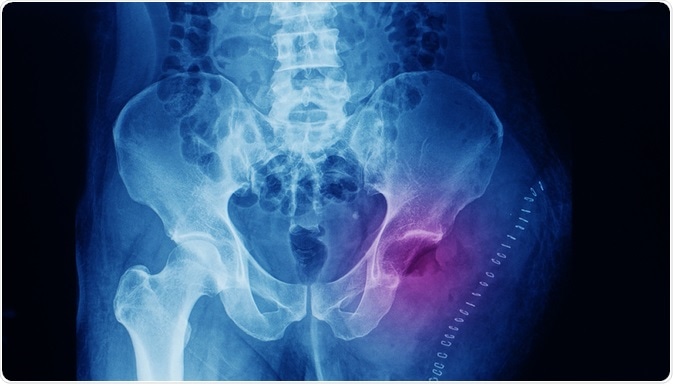Osteosarcoma is a malignant neoplasm of the bone and is the most common histological form of primary bone cancer. It is most prevalent in children and young adults, as it is associated with the formation and growth of bone. It is unsurprising, then, that it is the eighth most common type of childhood cancer.

Pelvis x-ray of a patient that has osteosarcoma at the thigh. The patient underwent left side hip disarticulation and wide excision of the tumor. Image Credit: Yok_onepiece / Shutterstock
Description
X-ray imaging reveals that the tumor is solid, hard, and irregular, with an appearance similar to a fir-tree or as if it has been moth-eaten. This distinctive look is likely due to the calcified bone radiating at right angles in the tumor spicules known as Codman’s triangle.
The tissue surrounding the osteosarcoma is usually infiltrated. The tumor cells are very pleomorphic (anaplastic), and some are large atypical mitoses on a microscopic level. The cells are known to produce osteoid, which are irregular trabeculae that may or may not have central calcification.
The cells are found within the osteoid matrix and can be classified according to their specific features, such as their resemblance to bone cells, cartilage cells, or fibroblast cells. They may also be multinucleated and exhibit osteoclast-like characteristics.
Location
Osteosarcoma most commonly occurs at growth sites of the bone because the osteoblasts proliferate in this region and may acquire mutations and lead to the condition. The localization of the tumor to the end of long bones, such as the metaphysis, is widespread.
The most frequently affected areas are the proximal end of the tibia or humerus, or the distal end of the femur. In fact, bones located around the knee region account for up to 60% of osteosarcoma cases – 42% in the femur and 19% in the tibia. Other bones often involved are those around the hip for approximately 15% of cases, 10% around the shoulder, and 8% in the jaw.
Development
Osteosarcoma originates from mesenchymal cells that are primitive transformed. This leads to the differentiation of osteoblastic cells and the production of malignant osteoid cells.
Some genes have been associated with the involvement of osteosarcoma genesis, such as the retinoblastic gene and the TP53 gene.
Causes
The primary cause of osteosarcoma remains to be seen, although it is likely that more than one factor may increase the risk of being affected. There is currently research being done that investigates the ability of cancer stem cells to cause tumors.
Radiotherapy used to treat previous medical conditions may be a cause. However, this is a rare circumstance, as most children and young adults are not subjected to radiotherapy.
It may also have a hereditary factor. In particular, families where chromosome 13q14 is deleted and the retinoblastoma gene inactivated face a higher risk of the condition. Additionally, Li-Fraumeni syndrome involves a mutation of the germline TP53 and is linked to osteosarcoma development.
Some other health conditions have been linked to the disease, such as bone dysplasias, Paget’s disease, fibrous dysplasia, enchondromatosis, multiple exostosis, and Rothmund-Thompson syndrome.
There has been some speculation as to fluoride's role in drinking water on the risk of developing osteosarcoma. This stemmed from a study in 1990 that presented a weak association between fluoride and cancer in mice. However, this has not been confirmed with sufficient evidence to claim that water fluoridation may cause the disease.
Osteosarcoma | Jaliyah's Story
Further Reading